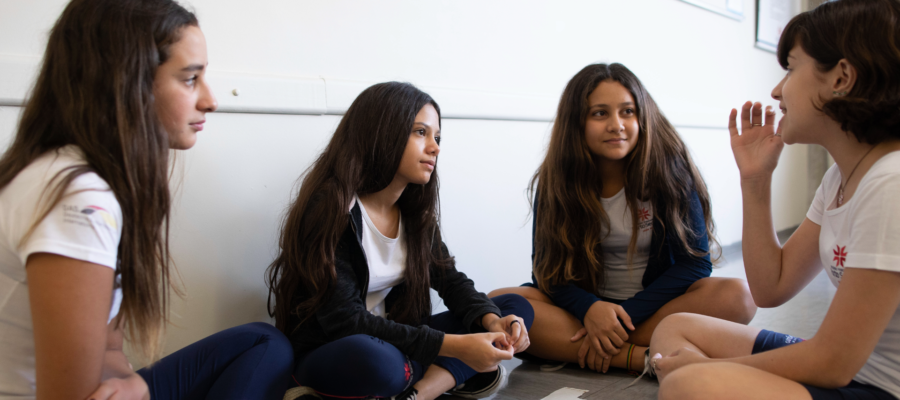As teachers, we want to create environments where our students feel connected with each other and us. We also want students to be motivated and feel empowered to fully participate in our classes. There are many ways to do this, but I’d like to discuss several practical strategies for creating community and supporting students.
Support Students: Let Students Know You Care
“As long as there’s good communication with a teacher, you get the hang of it. If not, it takes too long to figure out what you’re supposed to do.”
A high school student, as quoted in Carey, 2020
Decreasing students’ anxiety enables students to focus on the material and engage in successful learning, but when we shift to a virtual classroom, many students are initially overwhelmed. In addition to struggling with new technology, they are bombarded by messages, notifications, and information. In order to reduce affective barriers (e.g., “I didn’t do well on Zoom last semester.”), before the course starts, provide detailed, clearly written handouts that explain all of the technology that will be used. During the first virtual class, rather than assuming students understand the technology, have students practice using the platform’s online functions (e.g., writing on the interactive whiteboard) and online tools (e.g., the learning management system) so that they are confident and prepared for successful learning.
The distinguishing feature in keeping students engaged with virtual lessons is the “Support the student has when learning virtually. That makes all the difference.”
Associate Professor, Learning Technologies, George Mason University, as quoted in Carey, 2020
Particularly when studying online, students may feel lonely and vulnerable, so at the beginning and end of each class, greet students by name, recognizing them as individuals, not just numbers. Not only does this increase their sense of community but it also reminds them they are valuable to you.
Regularly (e.g., the end of each week) using a survey or feedback form allows us to better understand our students. First, we can discern students’ understanding of the content (e.g., “Why do you think Ryan is asked to appear on baking shows?”), and when necessary clarify in the next class. Second, we can gauge students’ emotional health (e.g., “What are some of the disadvantages of studying online?”),and provide personal support outside of class. Third, when we perceive students’ frustrations (e.g., “Did you have problems making or uploading the video? If so, please tell me in detail.”), we can address problems, thereby decreasing students’ anxiety. Finally, feedback forms can reveal students’ unspoken concerns, including connectivity issues during online courses.
Examples of questions include:
- Describe your data situation.
- Did you have any problems with technology PREPARING for class? If so, what problems?
- Did you have any problems with technology DURING class? If so, what problems?
Creating Community
Inside Class
“The question of the day” is an effective way to build community in the classroom. At the beginning of the semester, have students give you questions about things they would like to know. As you answer the questions throughout the semester, students realize you want to build a relationship and care about their interests.
Whether online or in the classroom, communication among students (including pair and small group work) is invaluable in both practicing the language and creating community, and by changing partners, we allow our students to make friends and hear various ways of saying the same idea. In the weekly feedback form, my students consistently noted that they liked having many partners because they could talk about various topics and learn about their classmates and me.
A third way to create community in the classroom is to ask students to brainstorm projects to do outside of class. Projects often scaffold 21st century skills, and by maintaining a safe social distance, students may be able to get out of their homes. Projects also develop students’ ability to collect data, which is then reported to classmates in class. Through these discussions, students learn about themselves and their classmates, as well as the larger world.
Outside of Class
Interactive homework not only extends content discussion and language practice but also provides a real-world audience. Using the learning management system, students can, for instance, share a photo of an outfit they like and write about why they like it. Classmates then respond or ask follow-up questions. Because our students are often visual learners, video posts and responses are another way to engage our learners and provide authentic audiences for using English outside of the classroom.

To learn more about students’ plastic challenge project and other teaching strategies, watch the entire webinar here.



Every time we teach, we motivate our students to learn more about the things they need to know, we are aware thins have not been easy due the current situation, specially since we are all social and learning is always a share of interpersonal skills and being away from the classroom may cause confusion to some students.
That’s the resson I also support the idea of creating an environment of confidence and good feeling student-teacher instead of a conductive tradicional way of teaching. We need to care more about the way every student is feeling in order to make him feel confortable, for instance his or her grades will be improve.
Every time we teach, we motivate our students to learn more about the things they need to know, we are aware thins have not been easy due the current situation, specially since we are all social and learning is always a share of interpersonal skills and being away from the classroom may cause confusion to some students.